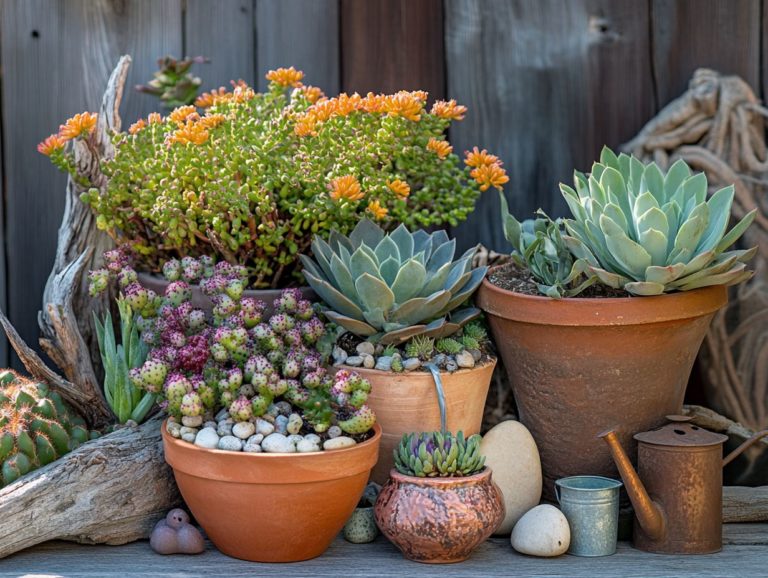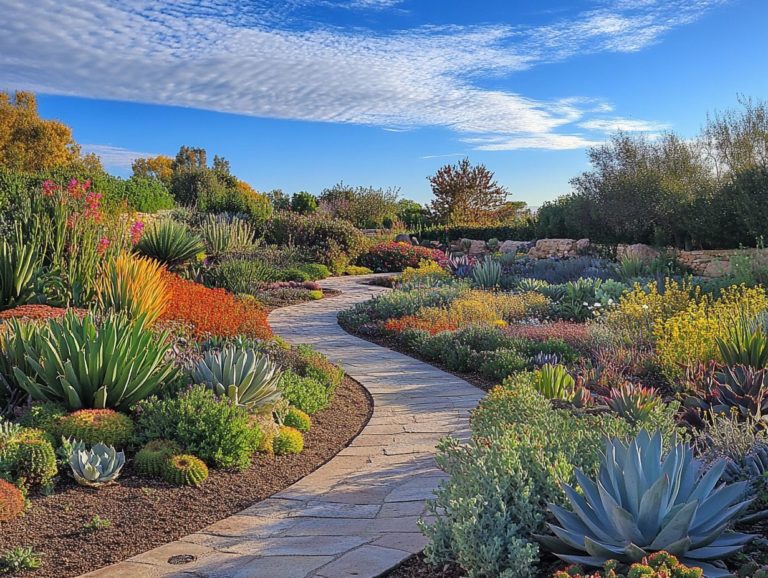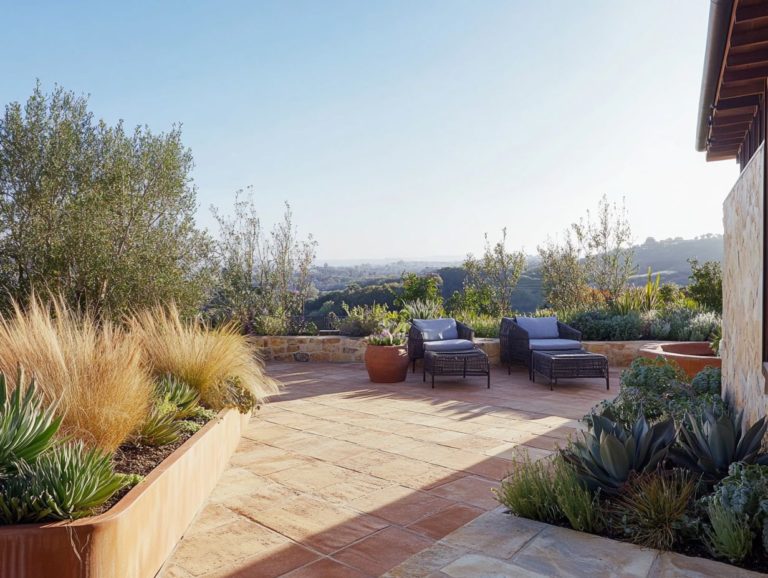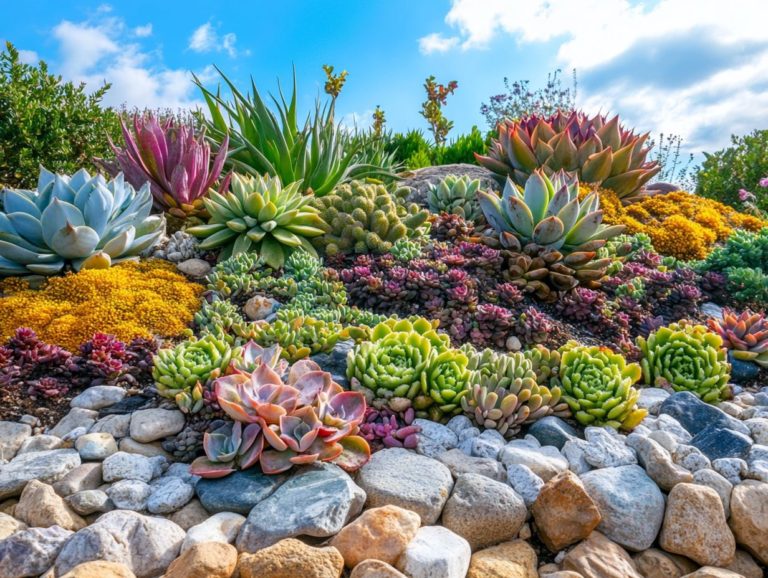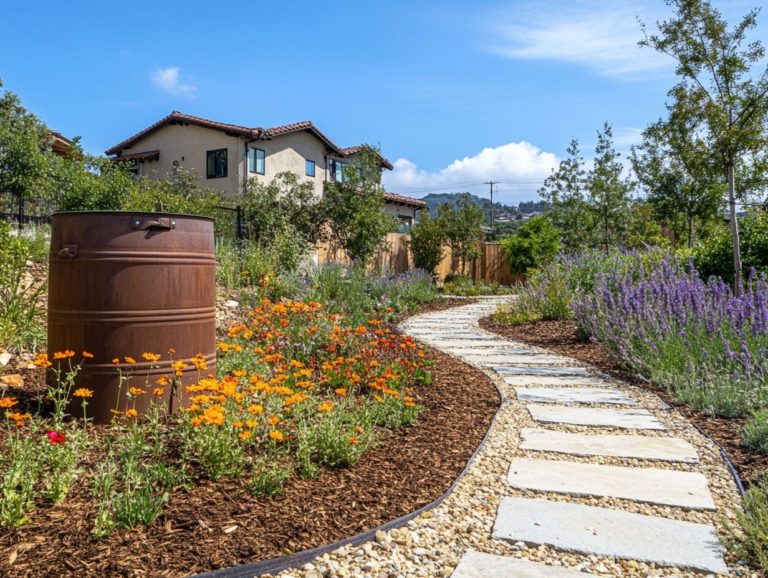5 Unique Drought-Tolerant Design Ideas
As climate change escalates, crafting sustainable landscapes is vital.
This article reveals five innovative design ideas that are drought-resistant and beautify your outdoor space. By using native plants and rainwater harvesting systems, you can create a garden that thrives even in dry conditions.
Discover the benefits of each idea and learn how to transform your yard into an eco-friendly oasis. Explore these practical solutions that blend beauty with sustainability!
Contents
- Key Takeaways:
- 1. Add Native Plants
- 2. Use Mulch and Compost
- 3. Set Up a Rainwater Harvesting System
- 4. Utilize Drought-Resistant Materials
- 5. Create a Xeriscape Garden
- What Is Drought-Tolerant Design and Why Is It Important?
- What Are the Benefits of Using Native Plants in Drought-Tolerant Design?
- How Can Mulch and Compost Help with Drought-Tolerant Design?
- What Is a Rainwater Harvesting System and How Does It Work?
- What Are Some Examples of Drought-Resistant Materials?
- How Can a Water-Wise Garden Save Water and Still Be Beautiful?
- Frequently Asked Questions
- What are some unique drought-tolerant design ideas for my garden?
- How can I design a drought-tolerant landscape that is also visually appealing?
- Can I still have a lush and green garden with drought-tolerant design?
- How can I maintain a drought-tolerant garden?
- Can I still have a variety of plants in a water-saving landscape?
- How can I make my water-saving garden low-maintenance?
Key Takeaways:
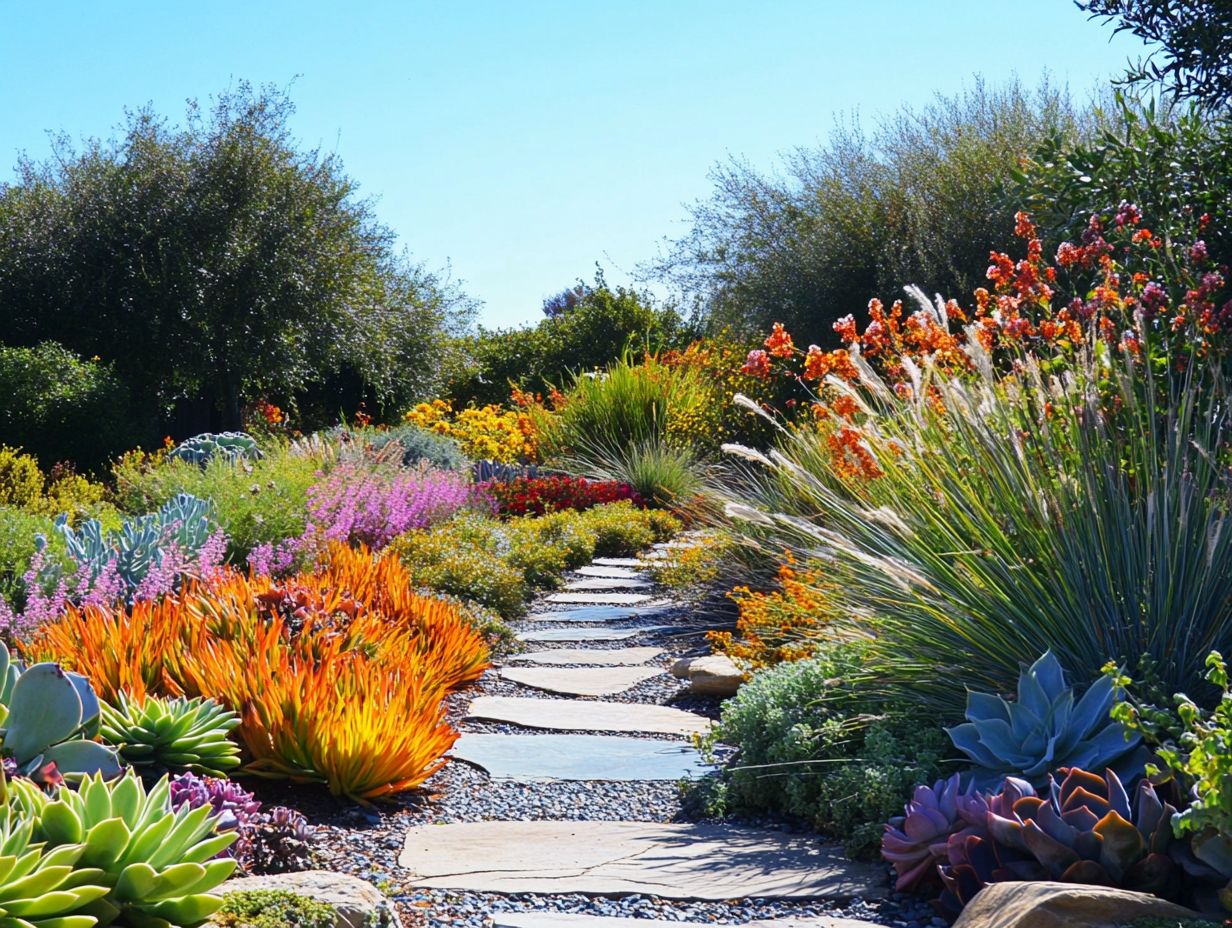
- Using native plants in drought-resistant designs adds beauty while conserving water and lowering maintenance costs.
- Mulch and compost are crucial for retaining soil moisture, fighting weeds, and nourishing plants.
- Installing a rainwater harvesting system helps you collect rainwater for future use, reducing reliance on traditional water sources.
1. Add Native Plants
Adding native plants to your garden is a key strategy for making it drought-resistant. These plants thrive in local climates and soils, promoting water conservation and enhancing local biodiversity.
For example, native plants like Echinacea (coneflower) attract pollinators and need little water once established. Achillea (yarrow) is known for its drought resistance and improves soil health with its deep roots.
By including these plants in your garden, you create a balanced garden that works with nature. They are not just beautiful; they also reduce water needs and build resilience against climate challenges.
2. Use Mulch and Compost
Using mulch and compost is vital for improving soil drainage and promoting water conservation, especially in drought-prone areas like Southern California.
These materials create a barrier that minimizes moisture loss while providing nutrients as they decompose. You can choose from various mulches like shredded bark, straw, and grass clippings based on your needs.
Adding compost enriches the soil, supports beneficial microorganisms, and promotes healthy root growth. Together, these elements create a sustainable landscaping plan, especially for drought-resistant plants.
3. Set Up a Rainwater Harvesting System
Setting up a rainwater harvesting system is an excellent way to conserve water. It helps you collect and use rainwater while lowering your reliance on municipal sources.
This system typically includes collection barrels under downspouts to gather runoff, along with filtration methods to keep the water clean. Integrating this system into your garden design allows you to maintain a vibrant landscape without draining local water supplies.
This practice works well with other sustainable efforts, such as composting and native plant landscaping, enhancing your eco-friendliness and supporting biodiversity in your outdoor spaces.
4. Utilize Drought-Resistant Materials
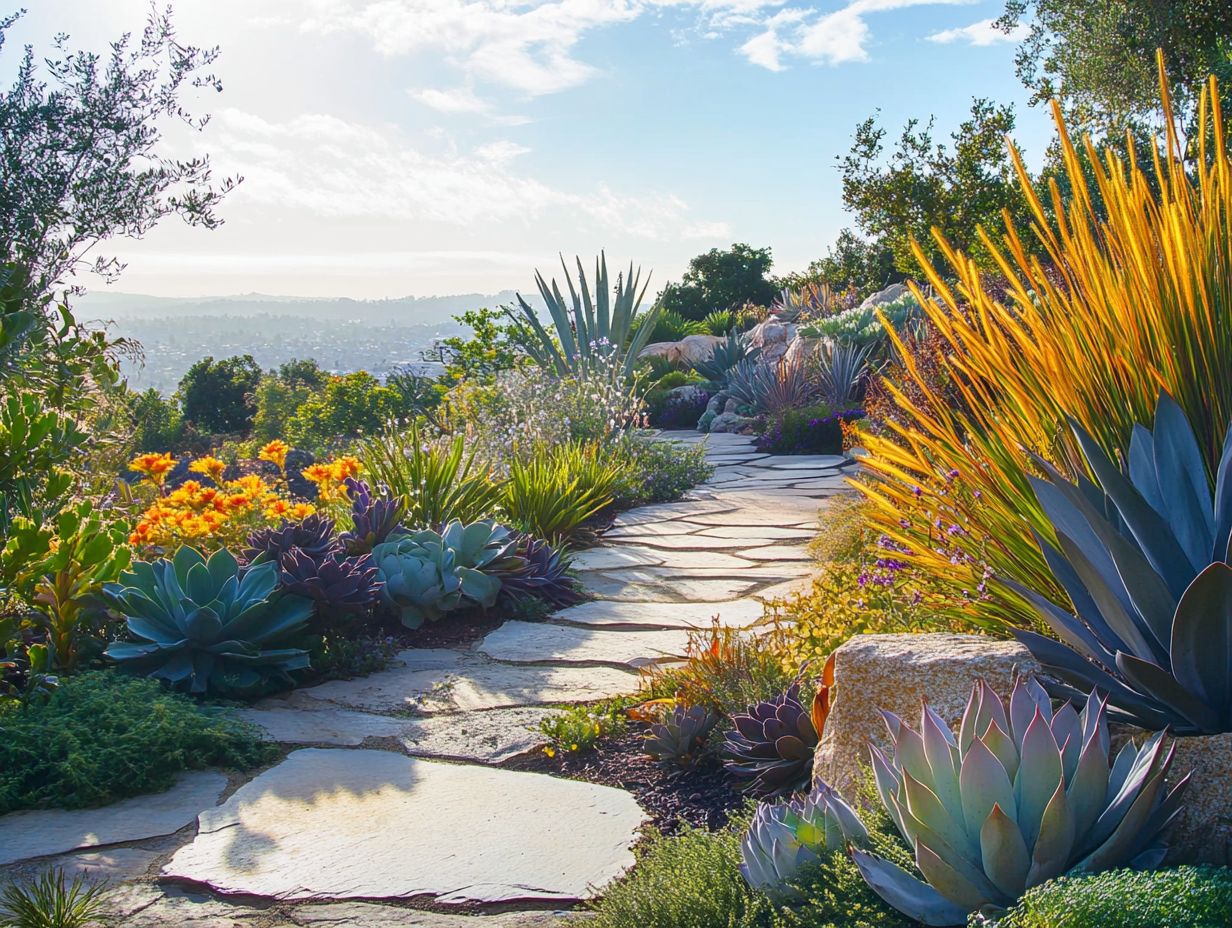
Utilizing drought-resistant materials in your landscaping design elevates the aesthetic appeal of your outdoor space while ensuring longevity and resilience against dry conditions. Exploring creative ways to utilize drought-resistant plants is a practical choice for conserving water.
You can craft a visually striking environment with elements like landscape rock and artificial turf. These materials significantly contribute to water savings.
Landscape rocks provide a natural look and aid in retaining soil moisture, benefiting surrounding drought-tolerant plants. Artificial turf delivers a lush, green appearance without the need for irrigation, making it ideal for minimizing water usage.
These materials blend seamlessly with low-water plants, creating a balanced garden design that flourishes even in arid conditions while keeping maintenance manageable.
5. Create a Xeriscape Garden
Creating a xeriscape garden is an innovative approach to landscape design that prioritizes water conservation. By incorporating drought-tolerant plants and efficient irrigation techniques, you can transform your outdoor space into a vibrant, sustainable ecosystem.
This design elevates the aesthetic appeal of your landscape. It also drastically reduces water usage and embraces eco-friendly gardening, making it a great way to learn how to design a drought-tolerant garden.
Select plants that thrive in arid conditions, like hardy succulents such as agave and colorful native herbs like sage and lavender. By implementing innovative ideas for drought gardening, you can cultivate a lush garden while minimizing the need for extra watering.
Choosing resilient species supports local wildlife and nurtures biodiversity. Beyond conserving water, xeriscaping lowers maintenance costs and fosters a deeper connection to the local ecosystem.
What Is Drought-Tolerant Design and Why Is It Important?
Drought-tolerant design emphasizes low-water plant selections and innovative irrigation methods. Implementing 5 ways to enhance drought landscapes creates beautiful outdoor spaces while conserving precious water resources, especially in drought-prone regions like Southern and Northern California.
As climate change progresses, ushering in unpredictable weather and extended dry spells, adopting innovative techniques for drought landscaping is crucial for sustainable living. By adding native and xeriscape plants to your landscape, you can significantly reduce your water consumption while nurturing ecosystems that flourish in scarcity.
This environmentally conscious approach beautifully combines functionality with aesthetics, demonstrating that gardens can be both resilient and visually captivating. Such designs enhance the natural beauty of your outdoor spaces and promote biodiversity, creating serene sanctuaries that invite mindfulness and foster a deeper connection with nature.
What Are the Benefits of Using Native Plants in Drought-Tolerant Design?
Utilizing native plants in your drought-tolerant design offers a wealth of benefits, including reduced water consumption and enhanced soil health. For more insights, check out the top 5 reasons to choose drought-resistant plants, as they are essential for sustainable landscaping practices.
These plants adapt naturally to your local climate, often thriving with minimal irrigation once established. Take the California poppy or the bluebell; these species flourish even in areas with low rainfall, significantly cutting down on the need for supplemental watering.
Native plants enhance garden aesthetics and attract local pollinators like bees and butterflies. This harmonious blend mirrors the beauty of the natural landscape and supports wildlife, ensuring your garden remains vibrant and lively throughout all seasons.
How Can Mulch and Compost Help with Drought-Tolerant Design?
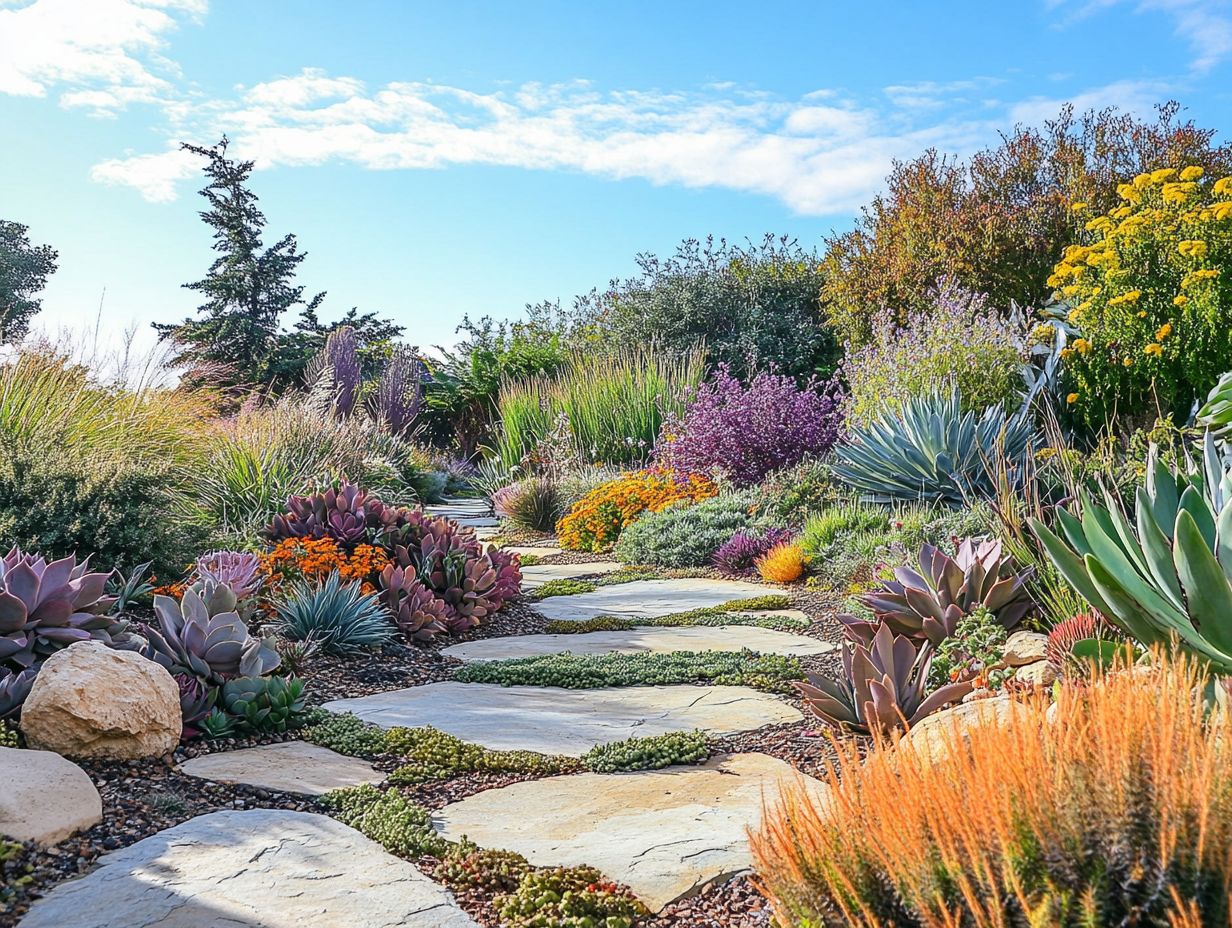
Mulch and compost are important elements in drought-tolerant design. They enhance soil drainage, retain moisture, and promote healthier plant growth. This combination facilitates effective water conservation strategies throughout your landscape.
These organic materials work together to create a thriving ecosystem beneath the surface. Mulch acts as a protective barrier that minimizes evaporation and suppresses weed growth. In tandem, compost enriches the soil with vital nutrients, improving its structure and nurturing beneficial microorganisms.
When applied correctly, mulch and compost ensure moisture is preserved during dry spells. They also enhance the soil’s long-term water retention capabilities. Imagine transforming your garden into a water-saving paradise by selecting resilient plant varieties that flourish even in challenging conditions. This approach promotes sustainability and reduces your dependence on supplemental watering.
What Is a Rainwater Harvesting System and How Does It Work?
A rainwater harvesting system is a smart way to conserve water. It allows you to capture and store rainwater for later use. This method reduces your need for regular water supplies and fosters sustainable practices in landscape design.
Typically, this system comprises several key components: catchment areas like rooftops, conveyance systems such as gutters and downspouts, and storage tanks for collection. By integrating these elements, you can gather substantial amounts of water during rainy periods.
When designed with drought-tolerant gardens in mind, this system optimizes water use and enhances plant health by providing a consistent source of moisture. Utilizing this system supports local ecosystems, encourages biodiversity, and minimizes runoff. Integrating native plants can maximize these benefits.
What Are Some Examples of Drought-Resistant Materials?
- Landscape rock
- Artificial turf
- Permeable pavers (pavers that allow rainwater to soak through, helping to reduce water runoff)
These materials enhance the aesthetic appeal of your garden while promoting effective water management in drought-prone areas. Choosing landscaping materials that require minimal maintenance can further reduce water use.
These materials serve a dual purpose, harmonizing functionality with beauty. For example, landscape rock not only reduces soil erosion but also adds a modern touch to your garden design.
Then there s artificial turf, which offers the lush look of natural grass without the extensive watering demands. This makes it an ideal choice for families and pet owners alike, especially in regions like Southern California where water scarcity is a pressing concern.
Permeable pavers play a crucial role by allowing rainwater to filter through, replenishing groundwater supplies and minimizing runoff. By incorporating these elements, you champion sustainability while ensuring the long-term resilience of your outdoor spaces against climate variability.
Start your drought-tolerant journey today and make a difference! Feel good knowing you’re helping the environment while enhancing your home!
How Can a Water-Wise Garden Save Water and Still Be Beautiful?
A water-wise garden offers you the opportunity to conserve substantial amounts of water while still presenting a breathtaking variety of colors, textures, and plant selections. It beautifully demonstrates that you don t have to compromise on aesthetics for the sake of sustainability, especially in drought-prone areas.
Get ready to craft a vibrant landscape that requires minimal irrigation by carefully choosing drought-tolerant plants that flourish in your local climate. For guidance on this, check out how to design a drought-tolerant landscape. Including native species not only boosts biodiversity but also ensures that these plants are perfectly suited to thrive in your environment, significantly reducing the need for extra watering.
Utilizing smart watering techniques, like drip systems which deliver water directly to plant roots and soaker hoses that allow water to seep out slowly allows you to water precisely, minimizing waste while still nurturing the plants. These principles help create outdoor spaces that are not only visually captivating but also reflect a commitment to environmental stewardship, promoting a sustainable gardening approach that delights both the eye and the ecosystem.
Frequently Asked Questions
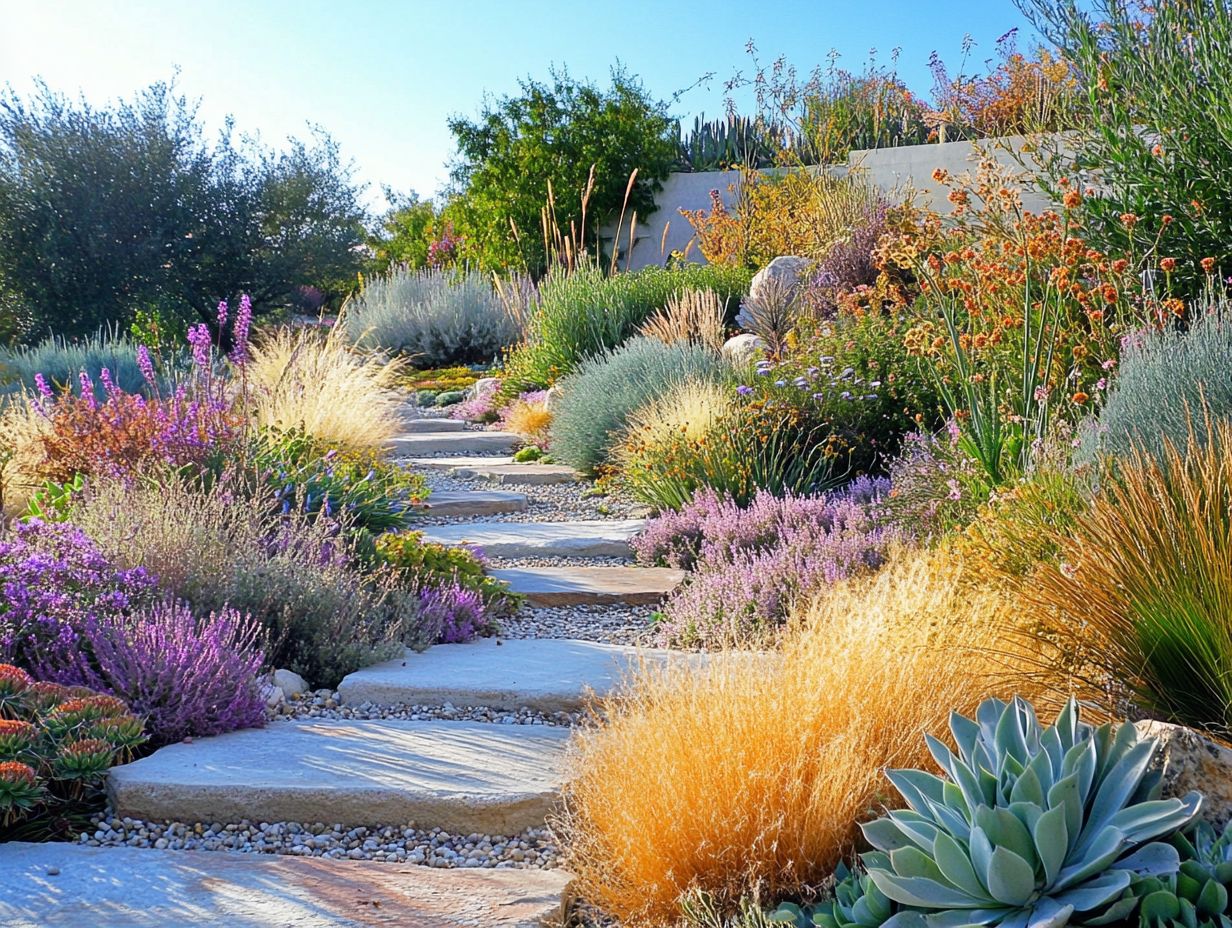
What are some unique drought-tolerant design ideas for my garden?
- Incorporate water-wise techniques such as using native plants, mulching, and drip irrigation to reduce water usage.
- Install a rainwater harvesting system to collect and store rainwater for future use in your garden.
- Use decorative rocks, gravel, or pebbles to create pathways and add visual interest while reducing the need for watering.
- Plant a variety of succulents and cacti, which are naturally drought-resistant and come in a range of shapes and colors.
- Create a vertical garden using drought-tolerant plants, such as herbs or succulents, to add greenery to a small space without using much water.
How can I design a drought-tolerant landscape that is also visually appealing?
- Mix and match different textures, sizes, and colors of plants to create depth and interest in your garden.
- Incorporate elements such as ornamental grasses, dry river beds, or boulders to add visual interest and break up the monotony of a drought-tolerant landscape.
- Play with different levels and layers by using raised beds, terraced plantings, or hanging plants to add dimension to your design.
- Use containers and pots to add pops of color and flexibility in your design, as these can be moved and rearranged easily.
- Consider adding a focal point, such as a water feature or sculpture, to draw the eye and add a unique touch to your landscape.
Can I still have a lush and green garden with drought-tolerant design?
- Yes, you can! Consider using drought-tolerant plants that resemble traditional plants, such as drought-resistant grasses or shrubs with small leaves.
- Mix in some drought-tolerant plants with more traditional plants to create a balanced and visually appealing design.
- Use groupings of plants and varying heights to create a full and lush look without relying on water-intensive plants.
- Choose plants that have interesting foliage or flowers, such as agave or lavender, to add color and texture to your garden.
- Use a combination of drought-tolerant plants and hardscaping elements, such as walkways or seating areas, to create a green and inviting space.
How can I maintain a drought-tolerant garden?
- Choose plants that are well-suited to your climate and soil type to ensure they thrive with minimal effort.
- Incorporate a layer of mulch around plants to help retain moisture and reduce the need for watering.
- Monitor watering and adjust as needed, taking into account factors such as weather, plant type, and soil conditions.
- Regularly remove weeds, as they compete with your plants for water and nutrients.
- Prune and trim plants as necessary to promote healthy growth and conserve water.
Start your drought-tolerant garden today to save water and create a stunning outdoor space! Check out these creative landscape ideas for drought areas and share your designs or tips for maintaining a drought-tolerant garden with us.
Can I still have a variety of plants in a water-saving landscape?
- Absolutely! There are plenty of colorful flowers and unique succulents that can add diversity to your garden.
- Choose plants with different bloom times for year-round color.
- Mix groundcover, shrubs, and trees for a layered look.
- Incorporate edible plants like herbs and vegetables for variety and functionality.
- Research plants with similar watering needs to help them thrive.
Start planning your water-saving garden today!
How can I make my water-saving garden low-maintenance?
- Pick plants that thrive in your area without much fuss!
- Try incorporating hardscaping elements like gravel or mulch to cut down on mowing and weeding.
- Use low-maintenance materials, such as decorative rocks or artificial turf, for visual interest without watering or trimming.
- Group plants with similar watering and care needs together to make maintenance simpler.
- Consider using water-saving plants that resist deer and pests, reducing the need for extra maintenance.
Start transforming your garden into a low-maintenance oasis today!

